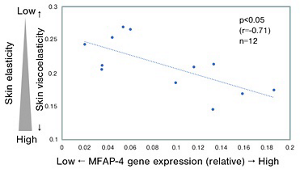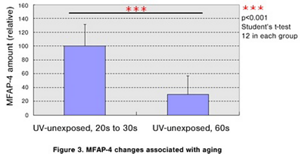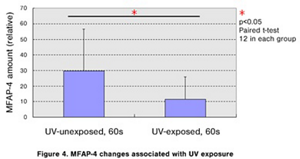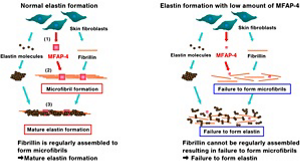MFAP-4, Important for Elastin Formation, Related to Elasticity in Human Skin, and Association of Reduced Level with Aging and UV Exposure - First Findings
The Biological Science Research Laboratory of Kao Corporation (President: Michitaka Sawada) has confirmed that skin elasticity is lower when the expression of microfibrillar-associated protein 4 (MFAP-4), essential for elastin formation, is reduced, and further that MFAP-4 amount decreases in association with aging and UV exposure.*1
Results of this study were presented at the 84th Annual Meeting of the Eastern Division of the Japanese Dermatological Association (held online, August 22 - 23, 2020).
-
* 1 Literature search for "MFAP4" or "MAGP36" using PubMed, the world's leading scientific literature database for supporting searches of life science and biomedical literature and retrieval of findings. No studies of the "relationship between MFAP-4 and cutaneous elasticity", or "decreased MFAP-4 amount in skin due to aging and UV exposure by quantitative analysis" were found (as of August 21, 2020, research by Kao).
Background
Kao researchers were among the first to notice the importance of dermal elastin as a causal factor of wrinkles and have been continuously performing related investigations for more than 30 years. Elastin is a protein complex consisting mainly of elastin molecules in a stacked formation. It has a highly elastic rubber-like construction and plays an important role in maintaining cutaneous elasticity.
In 2001, Kao researchers made a unique discovery regarding the expression of elastase (elastin degrading enzyme) inherent in skin by identifying an inhibitory substance. Later in 2011, Kao was the first to report that MFAP-4 is essential for formation of elastin. Those findings clarified that elastin formation is enhanced when the amount of MFAP-4 is high in cutaneous fibroblasts by which elastin is produced, whereas that formation is inhibited when the amount is reduced (Figure 1).*2
-
* 2 Essential role of microfibrillar-associated protein 4 in human cutaneous homeostasis and in its photoprotection, Scientific Reports 1:164, 2011.

Figure 1. Findings presented in 2011 showing relationship of MFAP-4 amount with elastin formation
Normal elastin formation is significant for maintaining skin elasticity. However, elastin is known to decrease and degenerate due to aging and UV exposure. In view of findings showing that the amount of MFAP-4 is involved in elastin formation, Kao researchers considered that its level might be related to human skin elasticity.
In the present study, the relationship between MFAP-4 expression and elasticity, as well as the effects of aging and UV radiation on MFAP-4 were quantitatively examined in human skin.
Relationship of MFAP-4 expression with skin elasticity
In the present study, 12 women in their 20s and 30s underwent measurements of MFAP-4 gene expression in skin on the inner part of the upper arm, considered to have a low level of UV radiation exposure. The relationship with viscoelasticity, one of the indices used for elasticity, was also determined. The results obtained are the first to confirm that elasticity is reduced with lower levels of MFAP-4 expression in human skin (Figure 2).

Figure 2. Relationship of MFAP-4 expression with skin elasticity
Decreased MFAP-4 amount in skin due to aging and UV exposure
To confirm changes in MFAP-4 level associated with aging, amounts*3 in skin in UV-unexposed (inner part of upper arm) and UV-exposed (external part of forearm) areas were compared between women in their 20s and 30s with those in their 60s. Those results confirmed that the amount of MFAP-4 was markedly lower in UV-unexposed areas of women in their 60s as compared to those in their 20s and 30s. These findings are the first to show that MFAP-4 level in human skin is decreased in association with aging (Figure 3).
-
* 3 Quantification by image analysis of MFAP-4 protein detected in skin.

Furthermore, a comparison of MFAP-4 amounts between UV-exposed and -unexposed areas of the women in their 60s revealed lower levels in exposed areas, confirming that MFAP-4 in human skin is reduced by chronic UV exposure (Figure 4).

Conclusion
The present quantitative results are the first to show that elasticity is low in human skin with reduced expression of MFAP-4, essential for elastin formation, and that its amount is decreased in association with aging and UV exposure. These findings confirm that MFAP-4 is closely linked with skin elasticity.
By making use of the findings obtained in the present study, Kao will continue to pursue research of elastin, with the aim to propose technology for realizing beautiful and healthy skin.
Related information
Kao research of elastin
| Major results of elastin studies | |
|---|---|
| 1984 | Started study of wrinkles |
| 1994 | Started study of elastin |
| 2001 | Identified elastase as specific to skin |
| 2011 | Discovered that MFAP-4 is essential for elastin formation |
| 2020 | First results showing relationship between MFAP-4 and skin elasticity, and reduced amount caused by aging and UV exposure in human skin |
Role of MFAP-4 in elastin formation
Elastin is formed by the following process:
(1) Proteins such as elastin molecules, MFAP-4, and fibrillin are produced by fibroblasts.
(2) Fibrillin is assembled to form microfibrils as a foundation for elastin.
(3) Elastin molecules bind to microfibrils to form mature elastin.
In step (2), the role of MFAP-4 is to assist with fibrillin assembly and form microfibrils at a relatively early stage of elastin formation.

Figure 5. Relationship of MFAP-4 amount with elastin formation
About Kao
Kao creates high-value-added products that enrich the lives of consumers around the world. Through its portfolio of over 20 leading brands such as Attack, Bioré, Goldwell, Jergens, John Frieda, Kanebo, Laurier, Merries and Molton Brown, Kao is part of the everyday lives of people in Asia, Oceania, North America and Europe. Combined with its chemical division, which contributes to a wide range of industries, Kao generates about 1,500 billion yen in annual sales. Kao employs about 33,000 people worldwide and has 130 years of history in innovation. Please visit the Kao Group website for updated information.
Media inquiries should be directed to:
Corporate Communications
Kao Corporation
